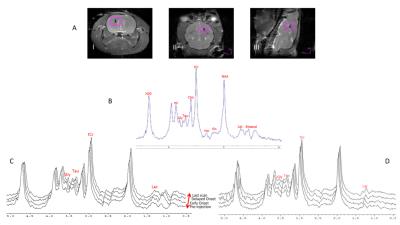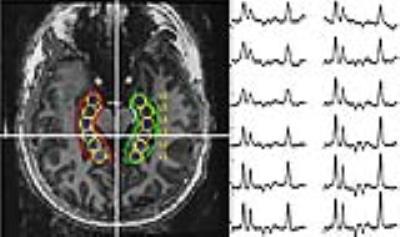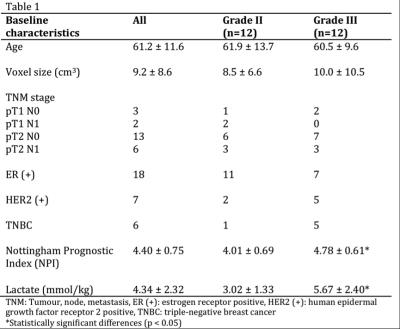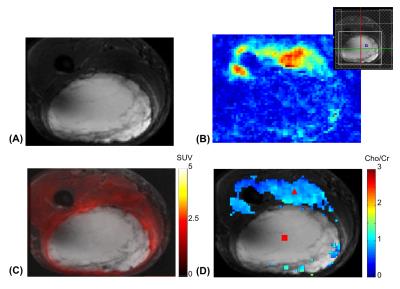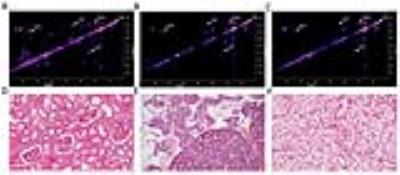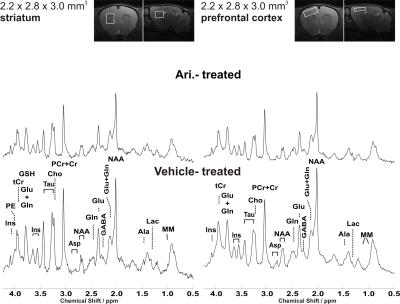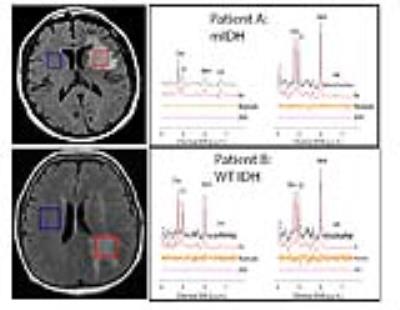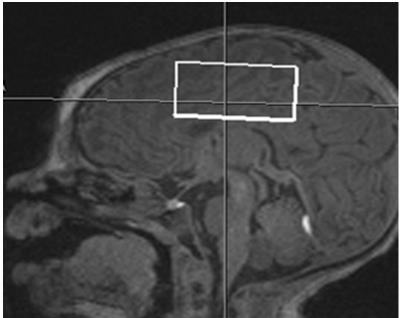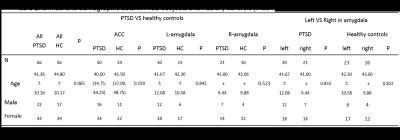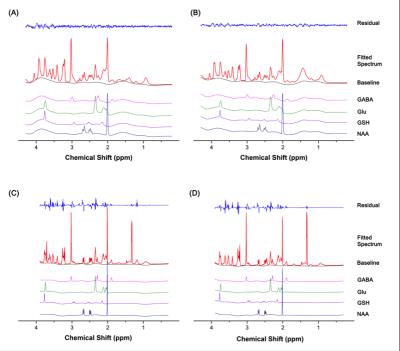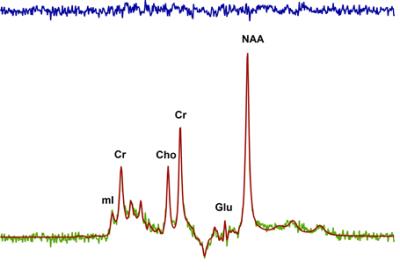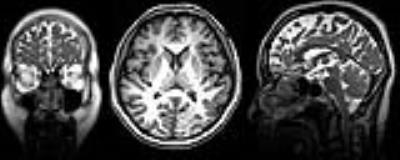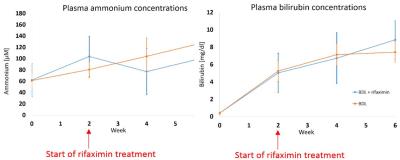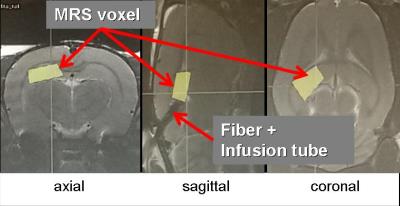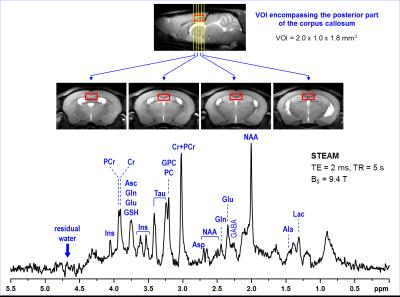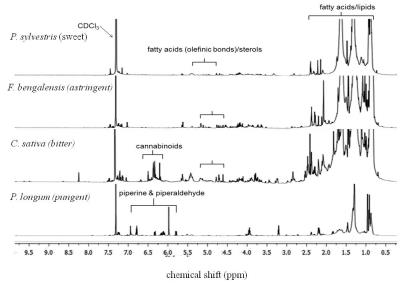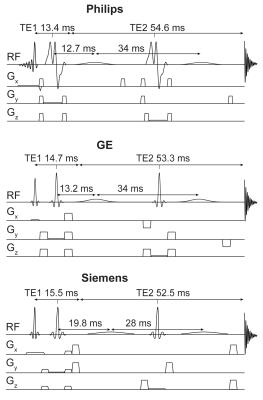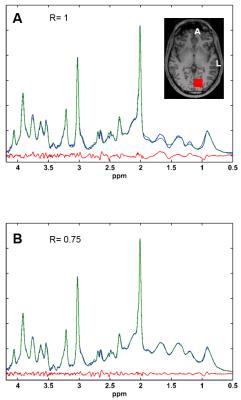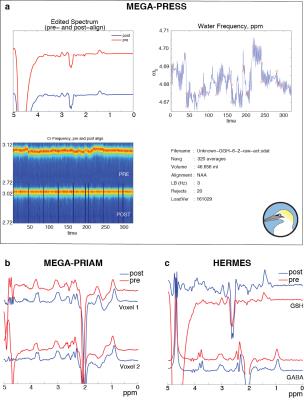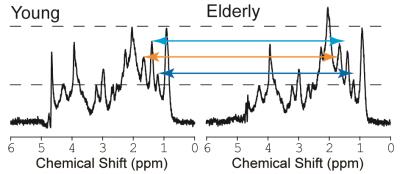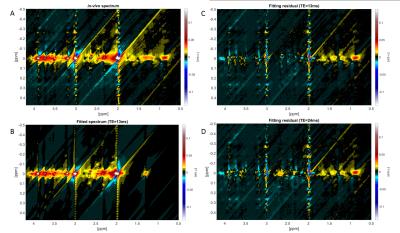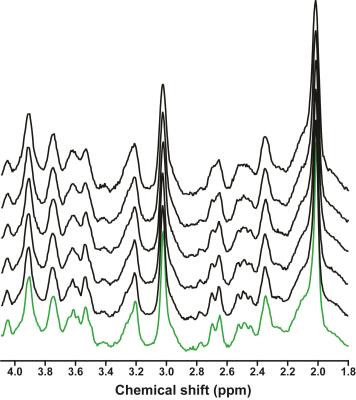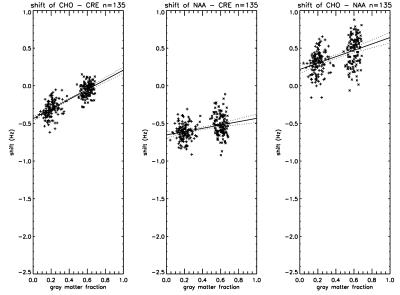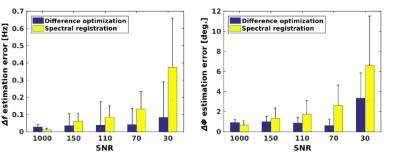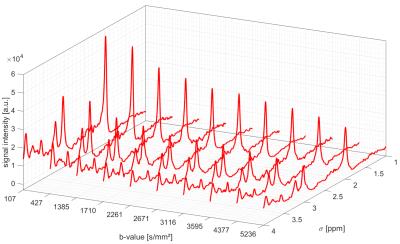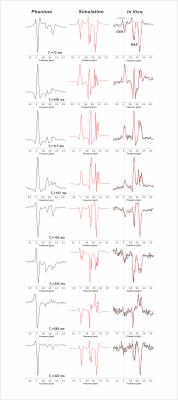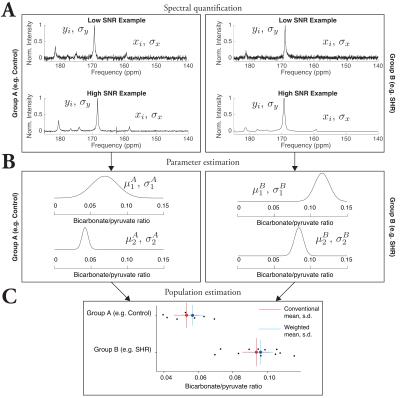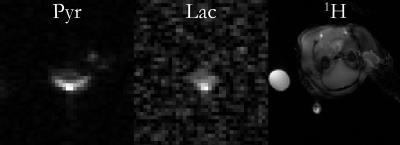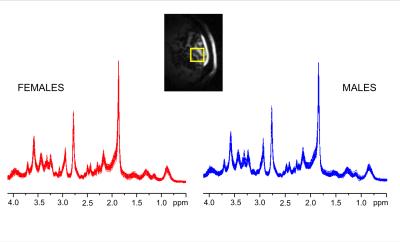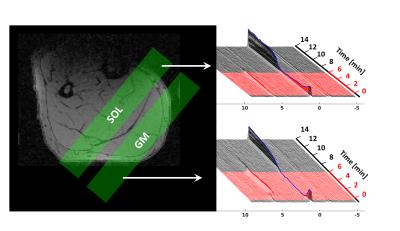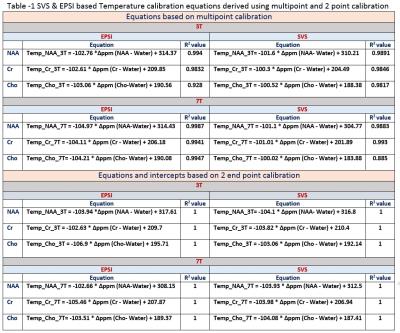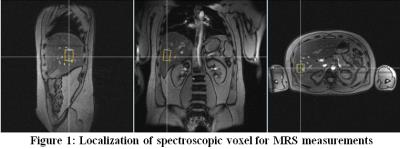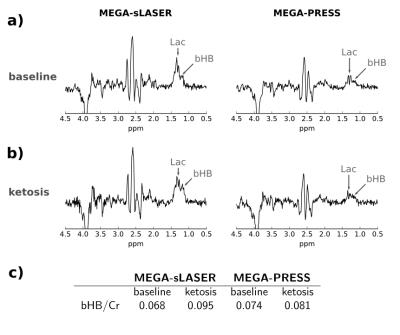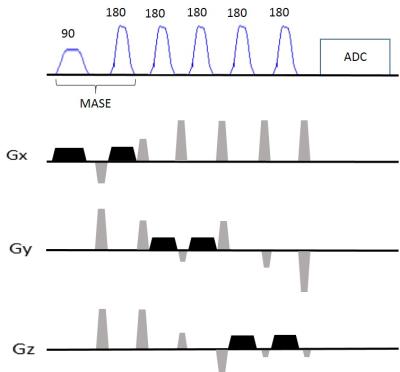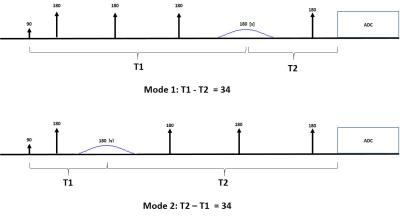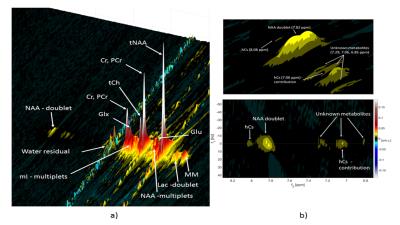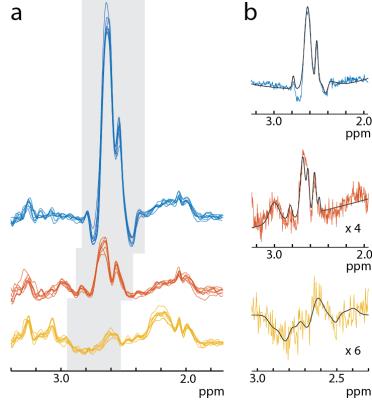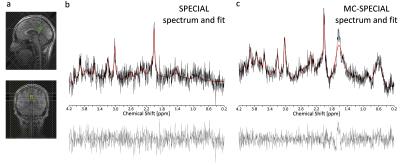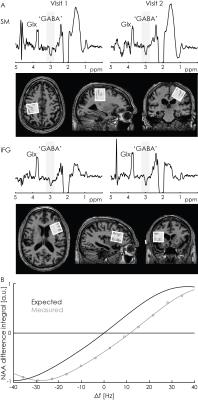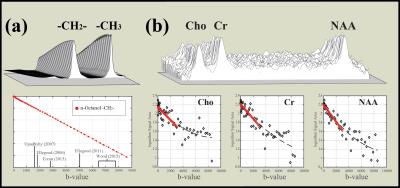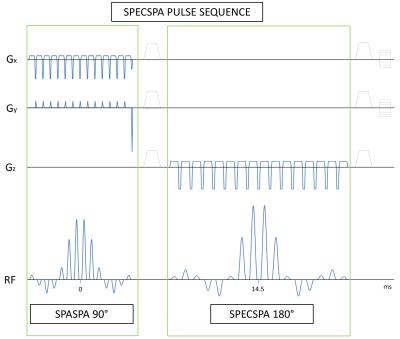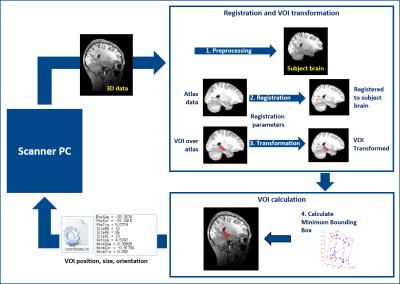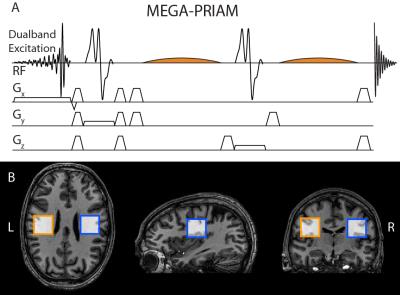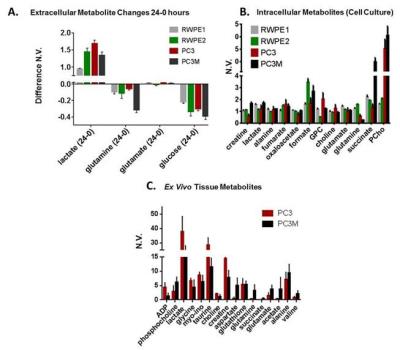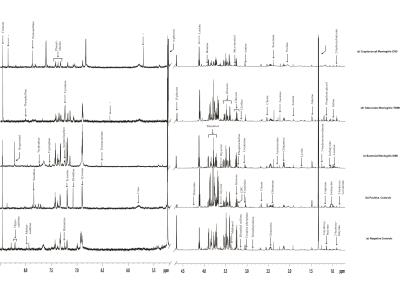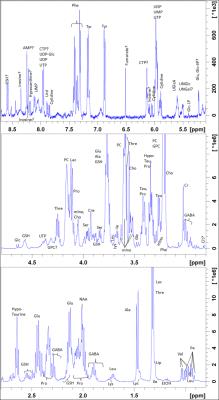Non-Proton MRI & MRS
Traditional Poster
MR Spectroscopy
Thursday, 27 April 2017
| Exhibition Hall |
13:00 - 15:00 |
|
2932. 
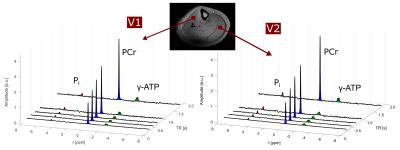 |
Mapping the exchange kinetics of high-energy phosphates in the human calf muscle by direct 31P MRSI at 7T
Andreas Korzowski, Sarah Neumann, Ludwig Dominik, Loreen Ruhm, Mark Ladd, Peter Bachert
31P MRS allows the non-invasive observation of high-energy phosphate turnover in vivo. A model incorporating the effects of exchange processes onto the transverse steady-state magnetization was derived, which allows the direct estimation of relaxation rates from signal intensities in MRSI datasets. Multiple 31P MRSI datasets with different excitation parameters of four healthy were evaluated. Spatially-resolved turnover rates of high-energy phosphates could be estimated and are in agreement with literature values proving feasibility of the proposed approach.
|
|
2951. 
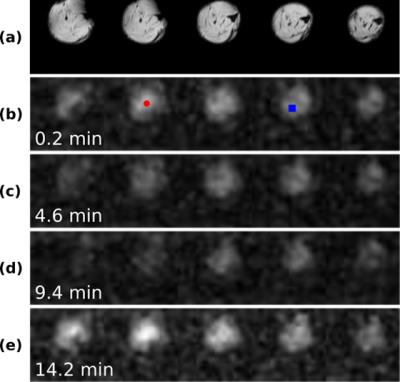 |
High Resolution Dynamic 31P-MRSI of Ischemia-Reperfusion in Rat Hindlimb at 9.4T Using SPICE
Yuchi Liu, Bryan Clifford, Chao Ma, Fan Lam, Zhi-Pei Liang, Xin Yu
Dynamic 31P-MRSI serves as a non-invasive tool to assess mitochondrial oxidative capacity in skeletal muscle during ischemia-reperfusion or exercise-recovery. However, 31P-MRSI with high spatial resolution requires long acquisition times which render dynamic measurements impractical. In this study, we adapted a recently proposed low-rank tensor-based method for high-resolution dynamic 31P-MRSI in preclinical studies. We present results from an in vivo ischemia-reperfusion experiment on a rat hindlimb with 15 s nominal temporal resolution and 0.75×0.75×1.6 mm3 nominal spatial resolution, demonstrating the potential of the method for assessing mitochondrial function in different muscle types in small animal models.
|
|
2936. 
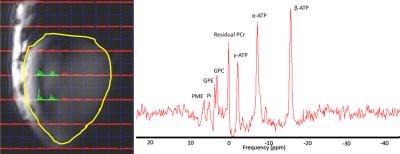 |
In vivo 31P spectroscopy of ATP levels during a fructose challenge in the liver at 7T
Irene van Kalleveen, Jurgen Runge, Wybe van der Kemp, Debra Rivera, Jaap Stoker, Dennis Klomp, Aart Nederveen
The standard evaluation of detecting liver parenchyma is invasive liver biopsy, while MRS is a non-invasive measurement to monitor metabolites. Using 31P spectroscopy it is possible to follow metabolic changes in the liver and the functionality of the liver during fructose uptake by measuring ATP levels. Going to ultra-high field strength, we are more sensitive to ATP levels and are able to use more localized MRS sequences (e.g. 3D CSI). We have shown we are able to monitor ATP levels during fructose uptake in vivo in the liver at 7T and see a decrease in ATP levels during the uptake.
|
|
2935.
 |
Dynamic 31P spectroscopy during superimposed electrical muscle stimulation and volitional contraction for enhanced metabolic response in the skeletal muscle
Francesco Santini, Dirk Fischer, Oliver Bieri, Xeni Deligianni
Dynamic 31P spectroscopy of the skeletal muscle can provide useful insight into its energy metabolism. However, in order to see dynamic changes in metabolites, a minimum threshold of physical exercise is necessary. In this work, we present a system that uses electrical muscle stimulation superimposed to volitional muscle contraction in order to enhance the metabolic response of the muscle in the same workload condition. This method can have potential application to patients that are unable to voluntarily exert sufficient work for a dynamic spectroscopy investigation.
|
|
2937.
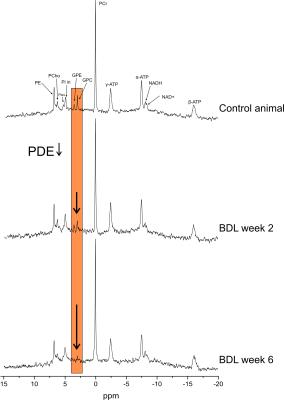 |
Chronic liver disease in developing brain: an in vivo longitudinal and multiparametric study using 31P MRS, 31P Magnetization transfer and 1H MRS
Veronika Rackayova, Vladimir Mlynarik, Cristina Cudalbu
Chronic liver disease (CLD) induces irreversible brain alterations, especially in children, probably linked with oxidative stress and energy metabolism perturbations. Our aim was to use combination of NOE enhanced and 1H-decoupled 31P-MRS, 31P-saturation transfer experiment (to estimate mitochondrial creatine kinase rate) and 1H-MRS to study the effect of CLD on developing brain. Our results show significantly reduced kATP→PCr and fluctuating NAD+/NADH ratio indicating perturbation in mitochondrial function, possibly induced by oxidative stress. In addition, altered phospholipid metabolism was observed.
|
|
2933. 
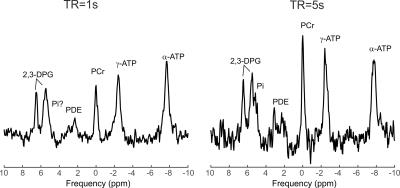 |
Measurement of human cardiac intracellular pH in vivo using long TR 31P-MRS with adiabatic excitation at 7T
Ladislav Valkovic, William Clarke, Lucian Purvis, Matthew Robson, Stefan Neubauer, Christopher Rodgers
Determination of human cardiac intracellular pH using 31P-MRS is challenging as the resonance frequency of Pi is concealed by a close resonating 2,3-DPG signal originating from blood. Common short TR and low-flip angle scan used for cardiac 31P-MRS increase the effective SNR/time, but can additionally suppress the Pi signal intensity. We have investigated the feasibility of detecting cardiac Pi and calculating intracellular pH of human heart using long TR 3D-CSI examination with adiabatic excitation at 7T. Comparison to short TR acquisition was performed using interleaved TR measurements. We report robust and repeatable detection of Pi signal in 100% of subjects.
|
|
2938.
 |
31P MR spectroscopy of peripheral artery occlusive disease patients with and without diabetes
Petr Sedivy, Miloslav Drobny, Monika Dezortova, Karel Roztocil, Andrea Nemcova, Vit Herynek, Robert Bem, Helena Cermakova, Jan Peregrin, Milan Hajek
Reduced blood supply limits the oxidative muscle metabolism and causes acidosis due to anaerobic glycolysis. Similar results were found in patients with peripheral artery occlusive disease (PAOD) in which chronic ischemia causes claudication and restricts walking distance. 31P MR spectroscopy of calf muscles of healthy controls and patients show that PAOD significantly influences muscular metabolism which is reflected in dynamic parameters of PAOD patients. The effect of diabetes is significantly pronounced in diabetic PAOD patients at rest compared to controls and PAOD patients without diabetes.
|
|
2934.
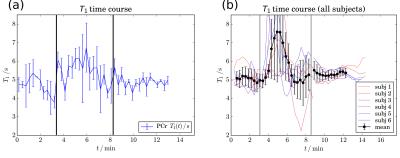 |
Phosphocreatine T1 in human gastrocnemius muscle at 7T increases during exercise, measured by localized 31P MRS with progressive saturation
Martin Meyerspeer, Albrecht Schmid, Fabian Niess, Georg Fiedler, Sigrun Goluch, Michale Wolzt, Ewald Moser
Alterations in T1 have implications on the physiological interpretation of dynamic high-energy phosphate data. Progressive saturation during rest-exercise-recovery experiments was used to simultaneously quantify PCr depletion, recovery and T1 values. The data were acquired using localised 31P MRS in human gastrocnemius. Apparent T1 values increased from 5.0 ± 0.4 s at rest to an average value of 5.8 ± 0.5 s during exercise, with a peak in early exercise and returning towards baseline values before exercise was ceased. These alterations may be explained by changes in the chemical exchange rates of PCr with ATP and Pi.
|
|
2939.
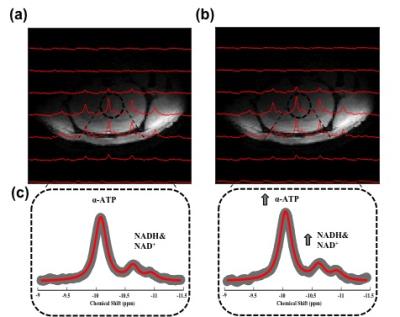 |
Exogenous NAD+ Enhances Energy Metabolism in Healthy Rat Brains
Ming Lu, Xiao-Hong Zhu, Yi Zhang, Wei Chen
Decline in NAD+ availability is tightly linked to many neurological disorders. Our recent study also revealed age dependences of intracellular NAD+, NADH and total NAD concentrations in healthy human brains. Accumulating evidences have shown that the cellular NAD+ could serve as a therapeutic target for treating metabolic or age-related neurological diseases and promoting longevity. Therefore, to investigate the effect of exogenous NAD+ on intracellular NAD metabolism, the in vivo 31P-MRS NAD imaging assay developed in our lab was applied in normal rat brains at 16.4 T. Significant increases of cerebral α-ATP, total NAD and NAD+ levels were observed after the intra-peritoneal infusion of exogenous NAD+. This study not only demonstrates the feasibility of using exogenous NAD+ to enhance cerebral ATP and NAD metabolisms, but also provides an opportunity to better understand the roles of NAD metabolism in health and age-related disease.
|
|
2931. 
 |
Highly Accelerated 31P MRSI of Human Calf Muscles combining Flyback Echo Planar Spectroscopic Imaging (EPSI) and Compressed Sensing
Alejandro Santos Diaz, Michael Noseworthy
Very long acquisition times is the most important limitation against performing 31P magnetic resonance spectroscopic imaging (MRSI) in clinic environments. To overcome this limitation we show the feasibility of implementing in vivo highly accelerated 31P-MRSI combining flyback echo planar spectroscopic imaging (EPSI) and compressed sensing (CS) achieving a 12x12 matrix over a 24 cm field of view (FOV) in less than 6 minutes. Due to the denoising nature of CS the resultant SNR was also improved using this approach.
|
|
2950.
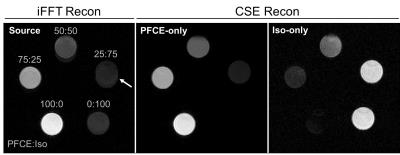 |
Chemical Shift Encoded (CSE) Image Reconstruction for Spectral Selection in Fluorine-19 MRI
Kai Ludwig, Diego Hernando, Nathan Roberts, Ruud van Heeswijk, Sean Fain
In preclinical applications, the high specificity of quantitative 19F MRI may be compromised by non-negligible signal contributions from fluorinated anesthetics (e.g. isoflurane). Here, we demonstrate the feasibility of chemical shift encoding (CSE) with multi-resonance fluorine signal modeling and least-squares estimation image reconstruction for 19F MRI. We optimize noise performance (NSA) and use a 3D spoiled gradient-echo acquisition to separate signal contributions from perfluoro-15-crown-5-ether (PFCE) and isoflurane. The method is tested in mixed PFCE/isoflurane phantoms showing effective signal separation. The CSE reconstruction removes isoflurane signal contributions in 19F MR images of PFCE in vivo, potentially reducing errors in 19F concentration quantification.
|
|
2944.
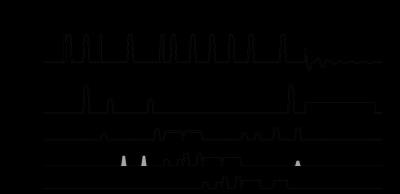 |
2D Heteronuclear Single-Quantum Coherence MR spectroscopy for in vivo detection of 13C-labeling in rat brain during simultaneous infusion of 13C-labeled substrates
Henk De Feyter, Kevin Behar, Douglas Rothman, Robin de Graaf
We adopted a 2D heteronuclear single-quantum coherence (HSQC) MR spectroscopy method to detect in vivo 13C isotopomers in rat brain through exploiting the high sensitivity of 1H MRS. This method allows for in vivo detection of unique 13C-labeling patterns in brain metabolite pools during simultaneous infusion of different 13C-labeled substrates. We demonstrated that high-quality 2D HSQC MR spectra can be acquired in vivo in a time-resolved manner from rat brain during simultaneous infusion of [U-13C6]-glucose and [2-13C]-acetate. This method can be used to study with high accuracy neuronal and glial metabolism, and the contribution of alternate substrates to brain energy metabolism.
|
|
2953.
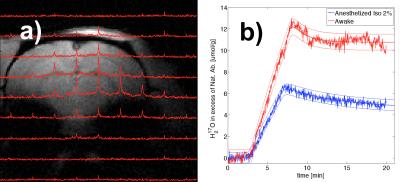 |
Measurement of CMRO2 in conscious rat with in vivo 17O MRS at 16.4T
Hannes Wiesner, Yi Zhang, Ming Lu, Nanyin Zhang, Xiao-Hong Zhu, Wei Chen
In this study we performed dynamic in vivo 17O MRS measurements in conscious and isoflurane-anesthetized rat during inhalations of 17O2-enriched gas at ultra-high field of 16.4T, ultimately to compare the relation between CMRO2 and brain condition.
|
|
2954.
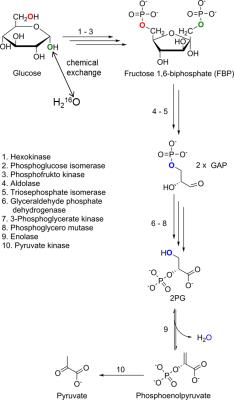 |
Quantification of Cerebral Metabolic Rates of 17O-Labeled Glucose in Mouse Brain with Dynamic 17O-MRS
Robert Borowiak, Wilfried Reichardt, Dmitry Kurzhunov, Christian Schuch, Benjamin Görling, Dieter Leibfritz, Jochen Leupold, Thomas Lange, Helge Haas, Jens Timmer, Michael Bock
We studied the chemical exchange kinetics of 17O-labeled glucose at the C1 and the C6 position with dynamic 17O-MRS. A profile likelihood analysis is performed to determine identifiability and confidence intervals of the metabolic rate CMRGlc. The exchange experiments confirm that the C6-17OH label is transferred via glycolysis exclusively by the enzyme enolase into the metabolic end product H217O, while C1-17OH ends up in water via direct hydrolysis as well as via glycolysis. From H217O-concentration time-courses cerebral metabolic rates of CMRGlc = 0.05-0.08 µmol/g/min are obtained which are in of the same order of magnitude as 18F-FDG PET.
|
|
2942.
 |
Automated Kinetic Modeling of Hyperpolarized 13C Metabolism in Human Brain Tumors
Jason Crane, Ilwoo Park, Marram Olson, Daniel Vigneron, Sarah Nelson
Methods for dynamic spectroscopic imaging of hyperpolarized (HP) 13C substrates are rapidly evolving and accessible tools are required for reconstructing the data and for validating quantitative kinetic models. This study presents processing tools for automatic analysis of data from dynamic HP 13C experiments. The methods were implemented in the open-source SIVIC software package and applied to the fitting of data from a human brain tumor trial to derive metabolic Kpl maps.
|
|
2941. 
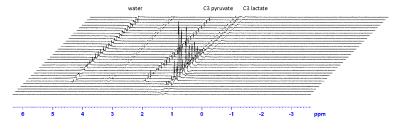 |
Measuring lactate dehydrogenase activity with proton detected 13C hyperpolarization
Felix Kreis, Jiazheng Wang, Alan Wright, Kevin Brindle
Dissolution Dynamic Nuclear Polarized NMR (dDNP NMR) is a promising new tool for assessing metabolism in vivo. The signals of the hyperpolarized substrate and its downstream metabolites are usually detected by direct 13C observation. Here we demonstrate an effective way to repetitively transfer hyperpolarization via indirect couplings from [1-13C] to [3,3,3-1H3] in [1-13C] lactate formed from hyperpolarized [1-13C] pyruvate. The changes in the hyperpolarized [3,3,3-1H3] lactate peak were fitted to a kinetic model. The method sets the stage for dynamic hyperpolarized 1H imaging.
|
|
2948. 
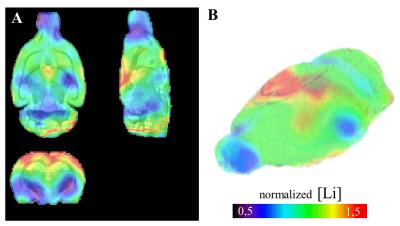 |
Investigation of Lithium Distribution in the Rat Brain ex vivo using Lithium-7 Magnetic Resonance Imaging at 17 Tesla
Anne-Sophie Hanak, Jacques Stout, Lucie Chevillard, Boucif Djemaï, Patricia Risède, Michel Luong, Eric Giacomini, Joel Poupon, David Barrière, Frank Bellivier, Bruno Mégarbane, Fawzi Boumezbeur
Lithium (Li) is the first-line mood stabilizer to treat bipolar disorder patients. However, its mechanisms of action and transport across the blood-brain barrier remain poorly understood. In this study, we aimed at mapping ex vivo the cerebral Li distribution of rats treated for 28 days with Li2CO3 using 7Li-MRI at 17.2 Tesla. Using a phantom replacement approach, MRI-derived Li concentrations were calculated and validated by comparison to inductively coupled plasma-mass spectrometry (ICP-MS) measurements. Lithium distributions were uneven (normalized lithium content ranging from 0.7 to 1.4) and symmetrical with consistently lower concentrations in the metencephalon and higher ones in the cortex.
|
|
2965.
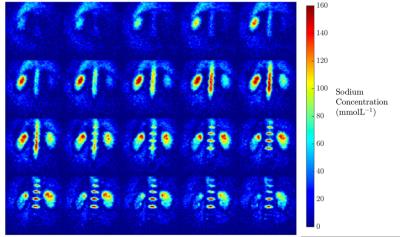 |
Quantitative Sodium MRI of the Human Kidney at 3T
James Grist, Frank Riemer, Esben Hansen, Mary McLean, Rasmus Tougaard, Joshua Kaggie, Martin Graves, Hans Stodkilde-Jorgensen, Ferdia Gallagher, Christoffer Laustsen
Imaging of the renal system with sodium MRI has gained interest in the past few years, especially in using the technique to quantify, and assess for, changes in the cortio-medullary sodium gradient. The main hindrance for previous work has been the lengthy scan time required to obtain sodium images. However, utilizing a 3D cones trajectory, the work presented here shows good detection of the cortio-medullary sodium gradient, in a clinically feasible scan time, in a sample of six healthy controls.
|
|
2957. 
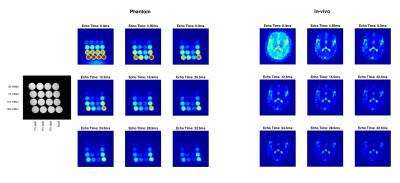 |
3D Multi-Echo Radial Imaging of $$$^{23}$$$Na (3D-MERINA) for time-efficient multi-parameter mapping
Yasmin Blunck, Sonal Josan, Brad Moffat, Roger Ordidge, Jon Cleary, Leigh Johnston
Challenging imaging characteristics (low SNR, fast bi-exponential decay) have so far limited the application of 23Na-MRI in clinical environments. This work presents 3D Multi-Echo Radial Imaging of 23NA (3D-MERINA), a time-efficient acquisition protocol from which multiple parameter maps (sodium-density, T2*slow and T2*fast, free 23NA) can be derived in a single acquisition. Phantom and in-vivo measurements were analysed for the evaluation of parameter mapping and the inference of tissue characteristic based on decay behaviour. All parameters were acquired in a single sodium-density-weighted acquisition under relatively low SAR. Future investigation will exploit 3D-MERINA for SQF-SNR enhancement and the detection of MQF contrasts.
|
|
2956. 
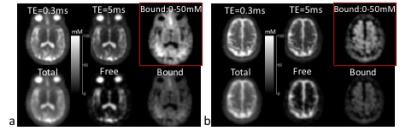 |
Proof of concept for the separation of free and bound sodium in human brain through two-TE acquisitions at 3T
Yongxian Qian, Tiejun Zhao, Karthik Lakshmanan, Yulin Ge, Yvonne Lui, Timothy Shepherd, Fernando Boada
In human brain, intracellular sodium ions (Na+) are in slow and restricted motion due to their binding to negatively-charged macromolecules while their extracellular counterparts are in fast and unrestricted motion. This difference in motion properties leads to changes in bi-exponential transverse decay of free and bound sodium ions, which have been explored previously as a means to separate free and bound sodium. In this study, a new approach is proposed to separate free and bound sodium using single-quantum sodium images, without the SNR and SAR limitations as encountered in the triple-quantum filtering approach.
|
|
2943.
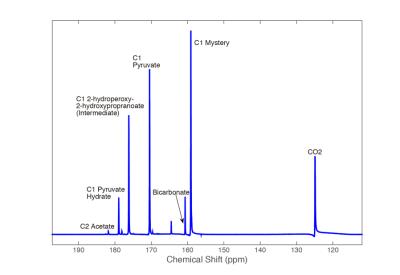 |
Analyzing Reaction Dynamics With Hyperpolarized 13C-NMR
Nicholas Drachman, Stephen Kadlecek, Rahim Rizi
In this study we use hyperpolarized 13C-NMR to probe the dynamics of the decarboxylation reaction of pyruvate via H2O2, commonly used to produce hyperpolarized bicarbonate. Using this method we are able to observe and quantify the dynamics of the intermediate state, 2-hydroperoxy-2-hydroxypropranoate, which has never before been directly observed at room temperature, as well as characterizing a previously overlooked side reaction between the products and reactants of the decarboxylation reaction. This study serves as a template for how to use hyperpolarized 13C NMR to study the dynamics of innumerable other organic reactions with polarizable substrates.
|
|
2958.
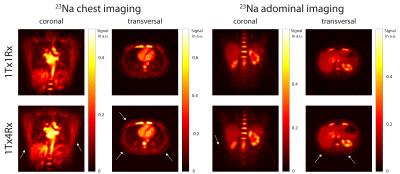 |
Elliptically-shaped 1Tx4Rx Coil for 23Na Body MRI at 7T
Tanja Platt, Nicolas Behl, Thomas Fiedler, Armin Nagel, Andreas Bitz, Peter Bachert, Mark Ladd, Mark Wielpütz, Hans-Ulrich Kauczor, Reiner Umathum
Up to now, only a few abdominal 23Na-MRI studies have been performed at 7T. In this work a 23Na body coil for 7T was enhanced. To achieve an improved homogeneity in the transmit field and in the receive sensitivity, transmit phase settings were optimized and four separate receive channels were implemented. Field distributions in a phantom were obtained for the original and the enhanced configuration. Both setups were applied to the human chest and abdomen. Transmit and receive homogeneity are markedly improved for the enhanced setup. Improvements for in-vivo image quality are especially visible in the contour of the body.
|
|
2940. 
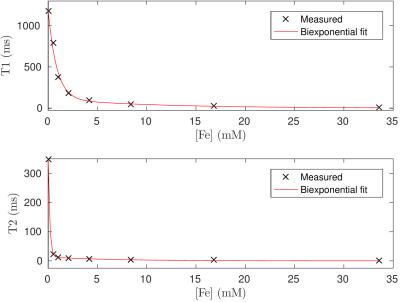 |
Ferumoxytol as a blood-pool T2 relaxation agent for 7T phosphorus spectroscopy
Jack Miller, Damian Tyler, Vicky Ball, Oliver Rider, Christopher Rodgers
Ferumoxytol is a licensed carbohydrate-coated, superparamagnetic iron oxide nanoparticle indicated in the treatment of anaemia. We show that, in contrast to other agents, it predominantly reduces T2, is confined to the blood pool for >1 hour post administration, and therefore could improve the efficiency of saturation pulses that aim to remove the 2,3-diphosphoglycerate signal from blood. This proof-of-principle study shows that Ferumoxytol could enable inorganic phosphate detection in vivo, and hence the determination of pH.
|
|
2946.
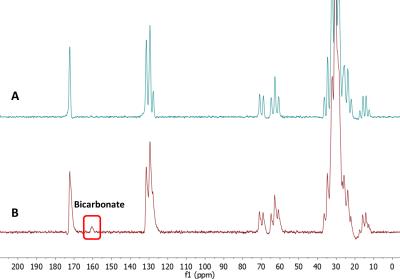 |
Protocol for investigating in vivo Glucose Metabolism in Human Breast Cancer by 13C MRS at 7T
Sergey Cheshkov, Ivan Dimitrov, Joseph Rispoli, Jiaming Cui, Mary McDougall, Steve Wright, Stephen Seiler, A. Dean Sherry, Craig Malloy
Upregulated glucose uptake in cancer is often observed and can be monitored with a radiolabeled analogue of glucose, 18FDG, with detection by PET, however, a well-known constraint is its ionizing radiation. Additionally, except for the trapping of that glucose analogue, PET does not provide information about subsequent glucose metabolism. Here, we demonstrated the feasibility of a simple glucose infusion protocol that allows detection of glucose oxidation in human breast cancer in vivo via 7T 13C MRS. The [U-13C]glucose infusion is performed outside of the magnet making the protocol significantly more suitable for patients compared to previous approaches that required prolonged 13C substrate infusions inside the scanner.
|
|
2945.
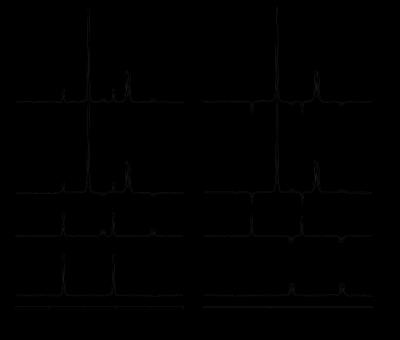 |
Localized, indirect 1H-[13C] MRS measurement of glutamate and glutamine 13C-labeling in frontal cortex of human brain at 4 Tesla.
Henk De Feyter, Raimund Herzog, Peter Brown , Douglas Rothman, Robin de Graaf
We present an indirect 1H-[13C] MRS detection method (selective proton-observed, carbon edited (selPOCE) that can be used in the frontal lobe of human brain, allows for separation of overlapping glutamate (Glu) and glutamine (Gln) peaks and provides well-defined spatial localization of the 13C-signal. The method was successfully implemented at 4 Tesla and allowed for the selective detection of13C-labeling in Glu and Gln in a timely manner (15 min), indicating that the selPOCE can be used for quantitative studies of brain energy metabolism and neurotransmission in a relatively small volume localized in the human frontal lobe.
|
|
2955.
 |
Direct Partial Volume Corrected CMRO2 Determination: Simulation assisted Dynamic 17O-MRI
Sebastian Niesporek, Reiner Umathum, Jonathan Lommen, Armin Nagel
A dynamic 17O-MRI inhalation experiment enables localized mapping of the cerebral metabolic rate of oxygen consumption (CMRO2) in the human brain via H217O quantification. These functional information are tissue viability parameters and can help studying the brain metabolism. In 17O-MRI, accurate quantification and CMRO2-determination is severely biased by partial volume effects caused by low spatial resolution and fast transverse relaxation. A human brain-simulation providing realistic dynamic 17O-data was used to evaluate the performance of a partial volume correction algorithm at different temporal resolution. Findings were then adapted to an in-vivo 17O-MRI inhalation experiment which was conducted in a healthy volunteer.
|
|
2959. 
 |
In Vivo Double Quantum Filtered 23Na Imaging of Human Skeletal Muscle
Lena Gast, Michael Uder, Armin Nagel
Double quantum filtered sodium (23Na) MRI represents a way to examine the degree of tissue microstructure but suffers from low signal intensity and therefore long acquisition time. In this work we developed an efficient simultaneous acquisition scheme of single and double quantum images and determined the optimum acquisition parameters for human skeletal muscle. The feasibility of double quantum filtered 23Na images of human lower leg at 3T was shown.
|
|
2960. 
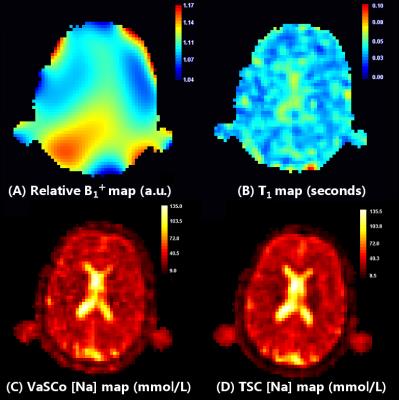 |
Variable Flip Angle Pipeline for in vivo Sodium Concentration Measurements (VaSCo)
Arthur Coste, Fawzi Boumezbeur, Alexandre Vignaud, Guillaume Madelin, Kathrin Reetz, Denis Le Bihan, Cécile Lerman, Sandro Romanzetti
This work presents a new method to measure Sodium concentration in human tissue using the Variable Flip Angle method with optimized acquisition parameters. Healthy volunteers were scanned and measures provided concentration values and T1 values in agreement with litterature values.
|
|
2952. 
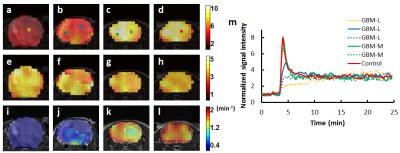 |
Dynamic Oxygen-17 MR Imaging with Golden-Ratio-Based Radial Sampling and k-Space-Weighted Image Reconstruction
Yuchi Liu, Yifan Zhang, Chunying Wu, Junqing Zhu, Charlie Wang, Nicholas Tomko, Mikhail Linetsky, Robert Salomon, Yanming Wang, Xin Yu
This study aimed at developing a 3D dynamic oxygen-17 (17O) MR imaging method to delineate the kinetics of 17O-water uptake and washout in mouse brain with glioblastoma at high temporal and spatial resolution. A 3D imaging method using a stack-of-stars golden-ratio-based radial sampling scheme was combined with k-space weighted image reconstruction to improve the temporal resolution with preserved spatial resolution. The proposed method achieved a temporal resolution of 7.56 s with a voxel size of 5.625 μL in mouse brain at 9.4T. It can also be used to image cerebral oxygen consumption rate in 17O inhalation studies.
|
|
2961. 
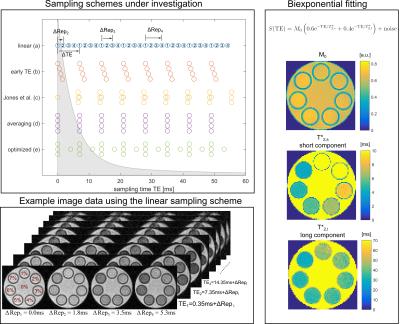 |
Optimizing the precision and accuracy of sampling schemes for T2* quantification of the fast biexponential decay of sodium MRI
Jonathan Lommen, Sebastian Flassbeck, Nicolas Behl, Mark Ladd, Armin Nagel
Sodium imaging is mainly performed with spin-density weighted sequences to quantify tissue sodium concentration. However, relaxation weighting can add additional specific information. We pursue appropriate sampling for low SNR and fast biexponential decay. The accuracy and precision of typical T2* measurements is determined for different sampling schemes by simulation and phantom measurements. We developed a dedicated sampling scheme for brain parenchyma employing numerical optimization. The results suggest that averaging is preferable to increase reliability compared to denser temporal sampling. In-vivo comparison confirmed the advantage of the optimized patter with increased separation of the decay components.
|
|
2964. 
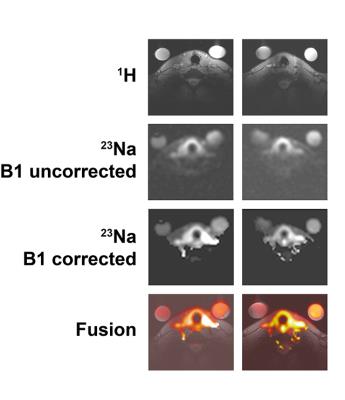 |
Sodium MRI of the thyroid gland at 7 tesla
Dimitri Welting, Wybe van der Kemp, Ingmar Voogt, Armin Nagel, Mark Ladd, Peter Luijten, Alexander Raaijmakers, Dennis Klomp, Nicolas Behl, Mariska Luttje
This work shows the potential of sodium imaging of the thyroid gland in vivo at 4mm isotropic resolution integrated to 1H imaging. An optimized setup combined with tuned sequences and B1 corrections enables quantitative sodium mapping of the thyroid gland and its surrounding tissue. The thyroid gland has the highest concentration of sodium in this part of the neck, estimated to be 64.5 mmol/L in vivo. Sodium imaging might open up the detection of (lymph node) metastases of thyroid cancer, as they are expected to exceed the healthy concentration of sodium detected in the head and neck region.
|
|
2947.
 |
Human In Vivo 25Mg Spectroscopy and Imaging at 7T
Nicolas Behl, Armin Nagel, Florian Maier, Peter Bachert, Mark Ladd, Reiner Umathum
25Mg spectroscopy and imaging were performed for the first time in vivo. T1 and T2* of 25Mg were evaluated in model solutions and T2* was additionally estimated in vivo for the human calf. 25Mg spectroscopy of an MgCl2 model solution exhibits a single resonance attributed to free 25Mg2+ ions, while in vivo spectroscopy of a human calf displays an additional resonance possibly attributable to bound 25Mg. Phantom and in vivo 25Mg imaging of the human calf were performed with a voxel size of 25×25×25 mm3.
|
|
2962. 
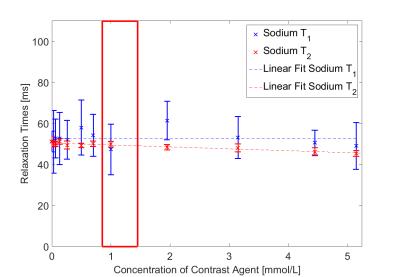 |
Influences of MRI proton contrast agent on sodium MRI at clinical 3T field strengths
Nadia Paschke, Wiebke Neumann, Tanja Gaa, Andreas Neubauer, Lothar Schad, Frank Zöllner
Sodium MRI enables to measure tissue sodium content (TSC) non-invasively, which provides additional cellular information and can serve as biomarker e.g. for tumor imaging. Thus, sodium imaging can complement standard clinical protocols. Many clinical routine protocols include perfusion scans with proton contrast agents but the influences on sodium relaxation times and therefore quantification accuracies of TSC are unknown. Our preliminary results showed no significant changes in sodium T1 and only small reductions of T2 with clinically relevant concentrations of contrast agents. Therefore, proton contrast agents are not expected to influence the TSC quantification in UTE sodium sequences.
|
|
2949. 
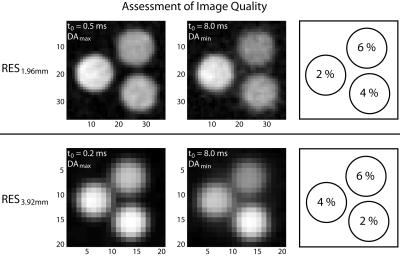 |
Density-Adapted k-Space Sampling Technique for Fast Relaxing Chlorine-35 Nuclei at 9.4 T
Ruomin Hu, Andreas Neubauer, Matthias Malzacher, Simon Konstandin, Lothar Schad
Chloride Cl- as the most abundant anion in mammals is a vital component of biophysical regulatory processes. 35Cl MRI has the potential to visualise Cl- homeostatic changes during stroke, in tumors and in ionic regulatory diseases. This study aimed at demonstrating the advantages of implementing density-adapted k-space sampling to overcome the instrinsically low SNR associated with 35Cl MRI. We showed that density-adapted k-space sampling yielded distinctively visible improvement of image quality as well as quantitative SNR gain in phantoms with very fast bi-exponential T2* relaxation over conventional radial sampling.
|
|
2963.
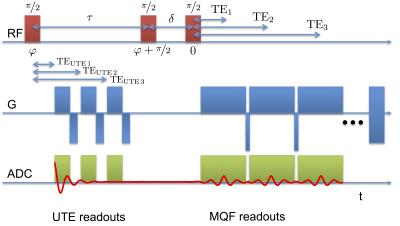 |
Relaxation in Simultaneously Acquired Single and Triple Quantum Filtered Sodium Imaging
Wieland Worthoff, Aliaksandra Shymanskaya, N. Shah
Sodium imaging delivers valuable information about metabolism and disease. The spin dynamics of sodium are significantly impacted by the environment of the nuclei, multiple quantum coherences might develop via the quadrupole interaction. This allows imaging with multi quantum filters (MQF) to achieve weightings towards different sodium compartments. MQF sodium signals are detected with three consecutive RF pulses, by placing a readout train between the first and second RF pulse, a fully quantitative characterisation of relaxation properties in a two-compartment model is possible from measurements within a single sequence.
|
|




































